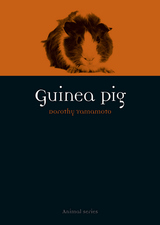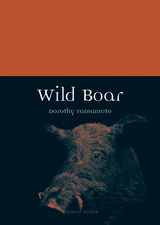3 books about Yamamoto, Dorothy

Animals on the Agenda
Questions about Animals for Theology and Ethics
Edited by Andrew Linzey and Dorothy Yamamoto
University of Illinois Press, 1998
This encyclopedic volume is the most comprehensive collection of original
studies on animals and theology ever published. Contributors from both
sides of the Atlantic tackle fundamental questions about theology and
how it is put into practice.
Do animals have immortal souls? Does Christ's reconciling work include
animals? Contributors address these issues and more in the context of
scriptural perspectives, the Christian tradition, historical disputes,
and obligations to animals.
As Andrew Linzey points out in his introduction, it cannot be right for
theological practitioners to carry on their business as though the world
of animals were invisible. Mainstream Christianity still propagates a
range of ideas about animals that are hugely detrimental to their status
and welfare. This important volume argues that it is time for a change.
studies on animals and theology ever published. Contributors from both
sides of the Atlantic tackle fundamental questions about theology and
how it is put into practice.
Do animals have immortal souls? Does Christ's reconciling work include
animals? Contributors address these issues and more in the context of
scriptural perspectives, the Christian tradition, historical disputes,
and obligations to animals.
As Andrew Linzey points out in his introduction, it cannot be right for
theological practitioners to carry on their business as though the world
of animals were invisible. Mainstream Christianity still propagates a
range of ideas about animals that are hugely detrimental to their status
and welfare. This important volume argues that it is time for a change.
[more]

Guinea Pig
Dorothy Yamamoto
Reaktion Books, 2015
Guinea pigs are one of the world’s most popular pets—small, friendly, easy to care for, and unbearably cute. We have felt this way for a long time: guinea pigs were first domesticated in 5000 B.C.E. Since then they have inspired historical figures ranging from the scientist William Harvey to the artists Jan Brueghel and Beatrix Potter. In this book, Dorothy Yamamoto offers the first in-depth treatment of this cuddly little creature over the several millennia it has been a part of our lives.
Yamamoto examines the role guinea pigs have today—as pets—but also looks back to less loving times when guinea pigs were put to more direct use. She discusses them as a crucial sacrificial offering to Incan gods, as the entrée in the Cusco Cathedral’s painting of The Last Supper, and as a highly favored experimental subject—for which they have become the quintessential metaphor for anyone in the same unfortunate circumstance. Threading her account with examples from the guinea pig’s many appearances in literature and art, Yamamoto reveals the personality and cultural importance of an animal we have always wanted to keep nearby, providing a fun and unique book for any animal lover.
Yamamoto examines the role guinea pigs have today—as pets—but also looks back to less loving times when guinea pigs were put to more direct use. She discusses them as a crucial sacrificial offering to Incan gods, as the entrée in the Cusco Cathedral’s painting of The Last Supper, and as a highly favored experimental subject—for which they have become the quintessential metaphor for anyone in the same unfortunate circumstance. Threading her account with examples from the guinea pig’s many appearances in literature and art, Yamamoto reveals the personality and cultural importance of an animal we have always wanted to keep nearby, providing a fun and unique book for any animal lover.
Published in Association with the Science Museum, London
[more]

Wild Boar
Dorothy Yamamoto
Reaktion Books, 2017
Ancestors of domestic pigs, wild boars are tough, resourceful omnivores that have presented humans since prehistoric times with a tricky situation: they make for a delicious food source, but they are formidable animals with long tusks that can inflict serious harm. Wild Boar traces the interaction of humans and boars in fascinating detail, showing how our relationship has evolved over time and how it can be seen today as fundamentally representative of the questions at the heart of ecological preservation and restoration.
Dorothy Yamamoto takes us from the dense streets of Tokyo to the Forest of Dean in England to show how wild boars have survived in a variety of settings. She also explores the ways that they have figured in our imaginations, whether as the iconic Calydonian Boar from Ancient Greece, the White Boar of Richard III, or any of the other forms it has taken in mythology and lore. As she shows, the boar has been an especially prominent figure in hunting culture, and as such it has often been construed as a larger-than-life monster that only the most heroic of us can take down, a misperception that has threatened the boar’s survival in many parts of the world. With an illuminating combination of natural with cultural history, this book paints a vibrant portrait of a unique and often misunderstood animal.
Dorothy Yamamoto takes us from the dense streets of Tokyo to the Forest of Dean in England to show how wild boars have survived in a variety of settings. She also explores the ways that they have figured in our imaginations, whether as the iconic Calydonian Boar from Ancient Greece, the White Boar of Richard III, or any of the other forms it has taken in mythology and lore. As she shows, the boar has been an especially prominent figure in hunting culture, and as such it has often been construed as a larger-than-life monster that only the most heroic of us can take down, a misperception that has threatened the boar’s survival in many parts of the world. With an illuminating combination of natural with cultural history, this book paints a vibrant portrait of a unique and often misunderstood animal.
[more]
READERS
Browse our collection.
PUBLISHERS
See BiblioVault's publisher services.
STUDENT SERVICES
Files for college accessibility offices.
UChicago Accessibility Resources
home | accessibility | search | about | contact us
BiblioVault ® 2001 - 2024
The University of Chicago Press









